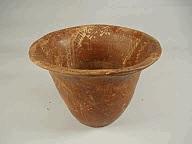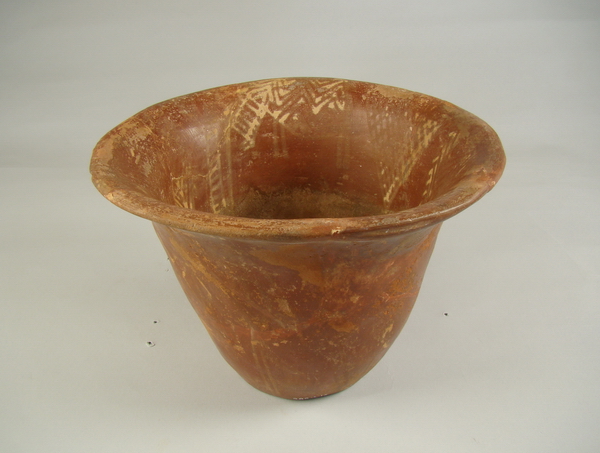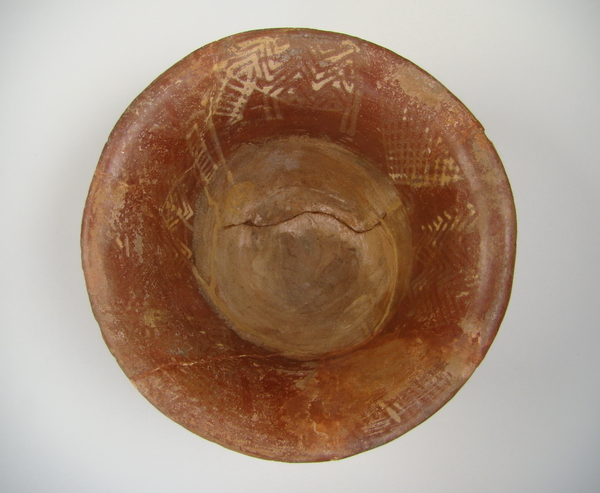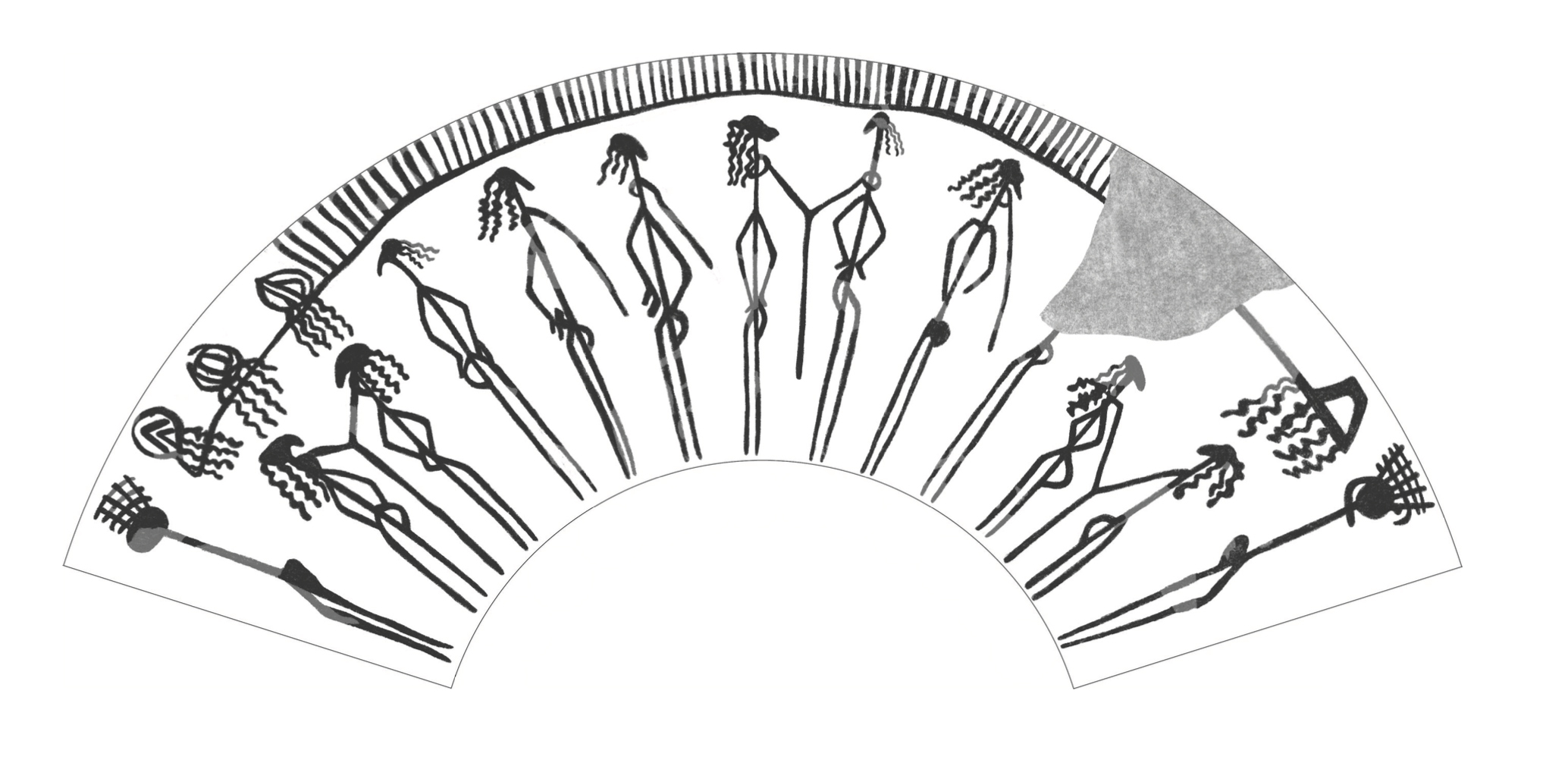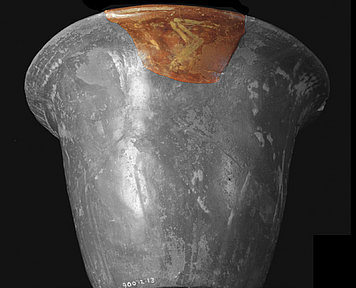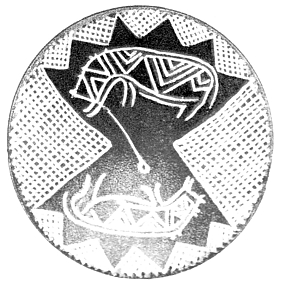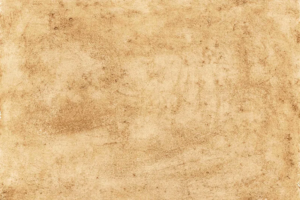C-Ware – beaker, squat C-0775
By Droux, Xavier
, Archaeological context unknown. 1900 : Bought by Charles Trick Currelly from Mohammed Mohassib, Luxor.Toronto, Royal Ontario Museum, 900.2.13.
Date : Naqada IA–IIB
General range of C-ware production
Material : Nile silt (Painted)
Preservation : Almost complete
Decoration preservation : Mostly faded
Preservation information :
The vessel is repaired from many fragments; a sherd is missing at the rim. Traces of filling material (plaster?).
Description
The vessel contains an extraneous sherd (C-0880) from a different C-ware vessel, likely added in modern times in order to fill a gap and increase the sale value of the beaker. The beaker is thoroughly slipped and polished on the outside, including the base, but only so in the upper part of the interior. The bottom of the interior, over which part of the painted decoration extends, was left rough.
Decoration
Inside, two hippopotamuses facing left, of which only one is fully preserved, on opposite sides of the vessel. Each hippopotamus is harpooned in the muzzle, from which the tusks protrude. The loop end of the harpoon, at the extremity of a long rope, is painted on the lower part of the interior, which is neither slipped nor polished. The body of the preserved hippopotamus is filled with a chevron deisgn, while the body of the other one appears to have been filled with curved lines that follow the outline of the belly. Their small tail is indicated.
In front of the preserved hippopotamus is an oblique, hashed narrow band, which touches the tip of the animal's snout. Further to the left is a vertical group of twelve parallel "W" zigzag lines, followed by a downturned crosshatched triangle which is just behind the second hippopotamus. In front of this hippopotamus is a partly preserved downturned hached triangle; further to the left, a second group of 10 to 12 parallel "W" zigaz, followed by a downturned crosshatched triangle.
On the outside, a narrow horizontal hatched band runs below half of the rim; below is a series of thirteen human figures. Two of them are larger than the others and are to be understood as 'victors' or 'chiefs'. They are placed back to back and face opposite directions, are shown without arms, and wear branches-headdresses. Their penish sheath are strongly indicated and differ from those of all other figures, which are all to be considered as prisoners.
Each 'chief' presides over a similar, mirrored scene. First, an identical group of two small-scale prisoners that face one another are attached to a pole by a rope bound to their throat. Their arms are joined at the hip, perhaps indicating that they are bound behind their back. The remaining seven figures are of medium size; the first one faces the 'chief' in both scenes; only one is fully preserved, but neither seems to be bound. Behind are two figures in one scene, one in the other scene, which all face to the right and have a long rope markedly looping around their neck. Their arms are always joining their hips, but without touching them, making it less obvious whether they are bound or not. Finally, a pair of prisonners, facing one another, are bound together, perhaps to a pole, althouth the vertical element between them does not reach the bottom of the scene.
The captives all have long, floating hair and a loop-like penis sheath. Above the two groups of small bound pairs of captives are unusual elements. In one case, there are three circles/spirales from which hang several long wavy vertical lines. In the other case, the preserved part has similar wavy lines hanging from a more triangular design. These tassel-like designs have been interpreted as possible early representation of a flail (Droux 2021) but they may represent the scalps of vainquished ennemies.
For description of the extraneous sherd, see C-0880.
Dimensions (cm)
13.1
19.1
19.1
Base diameter: 8.5
Additional information
Open
Vi 146
Oi 100
direct
flat base
Inside and outside
Comments
Lower half of inside is not slipped nor polished; part of the painted decoration extends over this area.
Acknowledgements
We thank Pr Grzymski, Senior Curator, and Cheryl Copson, Collection Technician, ROM, for facilitating the study of this artefact.
References
2021
Chiefs, bound captives, and harpooned hippopotamuses: an exceptional unpublished C-ware vessel in the Royal Ontario Museum, Toronto (inv. 900.2.13). Archéo-Nil 31
, passim, figs 1–8, table 1, no. 3, table 3, no. 9.2022
Evidence for the scalping of captives on a Predynastic White Cross-lined jar. Archéo-Nil 32
, 55–6, fig. 7.2022
A triumphal shrine depicted on an early Naqada III bowl from Qustul, Lower Nubia, in: Sperveslage, G. (ed.), Early Egyptian miscellanies. Discussions and essays on Predynastic and Early Dynastic Egypt. IBAES 26. Berlin – London
, 69, fig. 10.2024
Concept of power, iconography and anthropomorphic figure: beyond our devinition of the king, in: Tristan, Yann; Villaeys, Julie; Ryan, Ellen M. (eds), Egypt at its Origins 7: proceedings of the seventh International Conference "Origin of the State. Predynastic and Early Dynastic Egypt", Paris, 19th–23rd September 2022. Orientalia Lovaniensia Analecta 323. Leuven
, 800–801, fig. 1c.